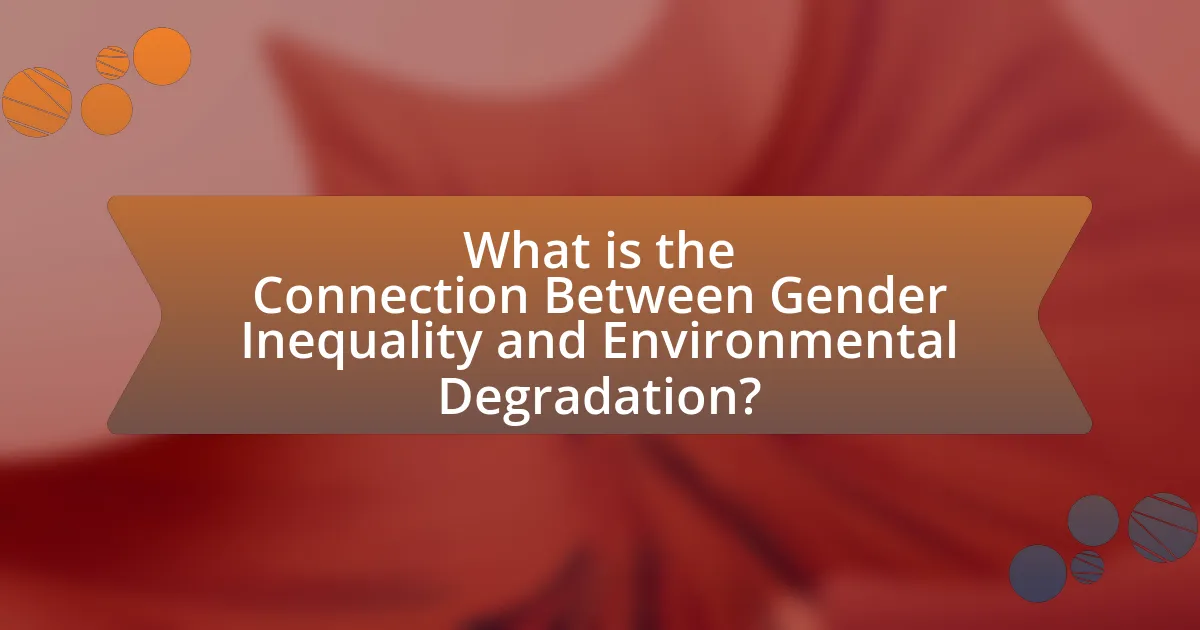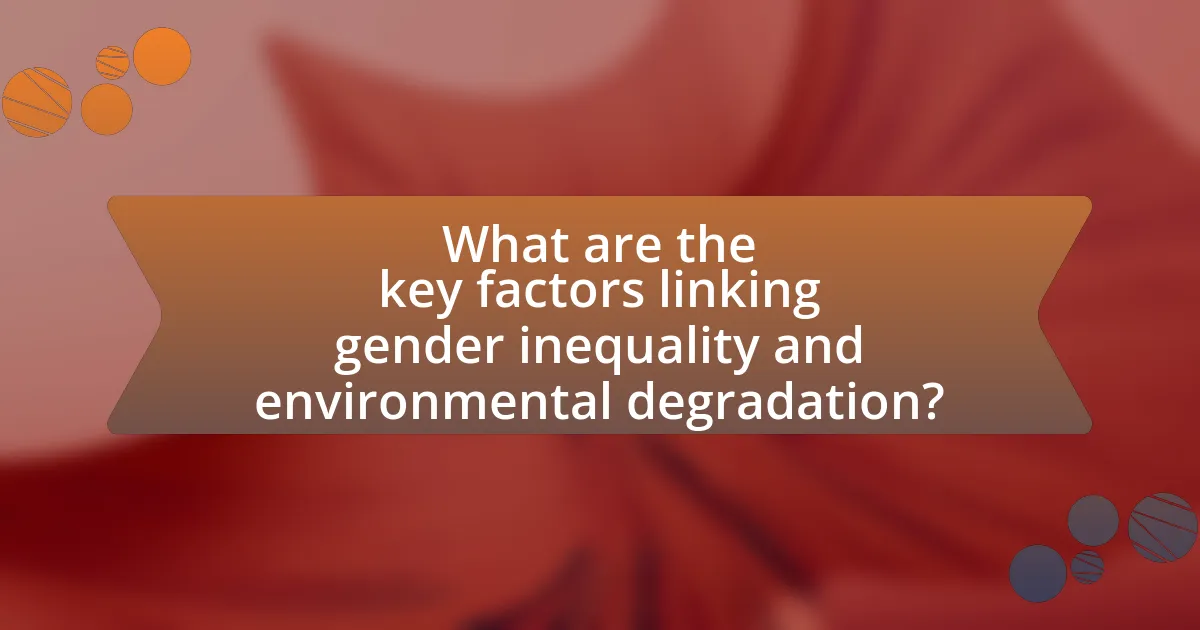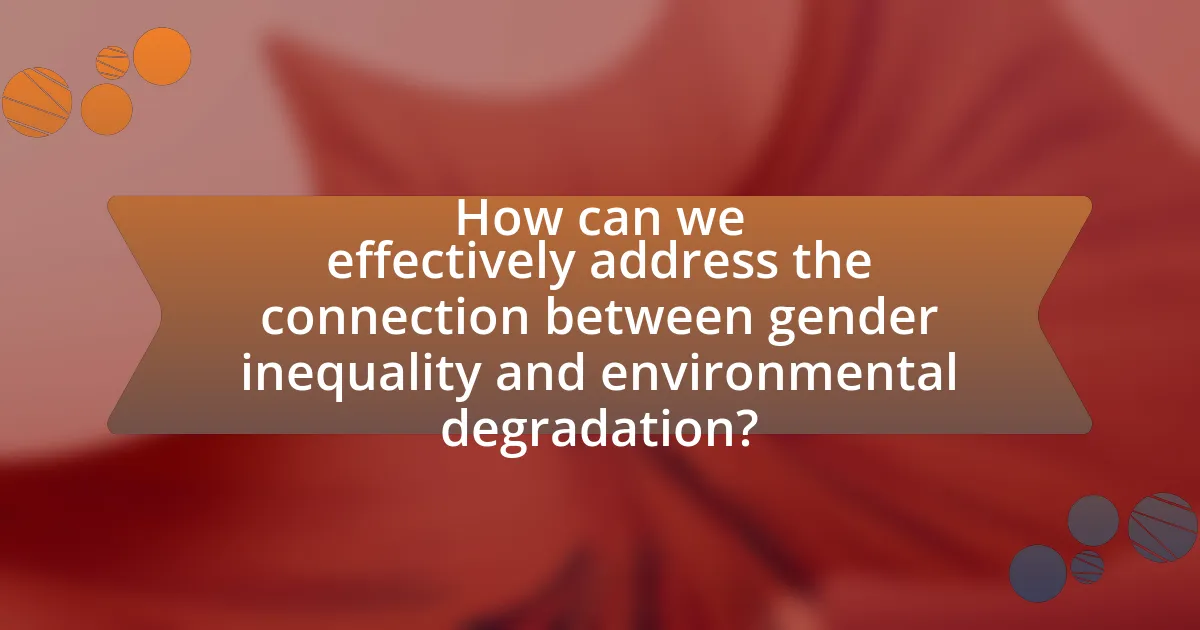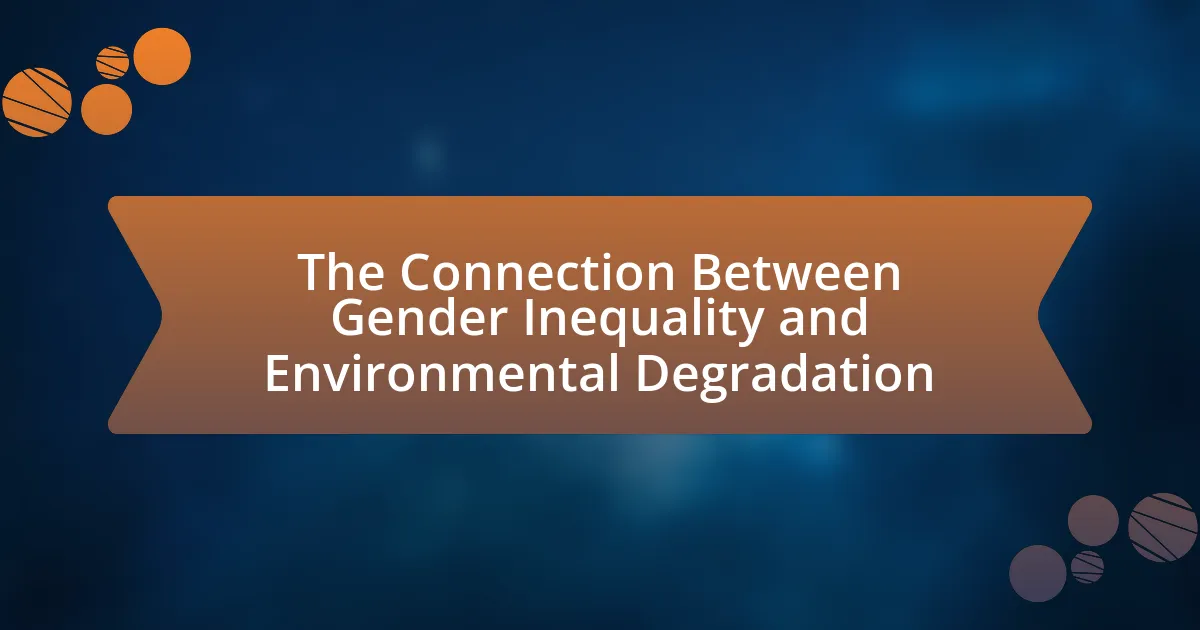The article examines the connection between gender inequality and environmental degradation, highlighting how disparities in access to resources, decision-making power, and education hinder women’s contributions to sustainable practices. It discusses the significant roles women play in managing natural resources and how empowering them can lead to improved environmental outcomes. Key factors linking gender inequality to environmental issues include unequal resource access and the impact of traditional gender roles on resource management. The article emphasizes the importance of integrating gender perspectives into environmental policies to enhance sustainability and community resilience.

What is the Connection Between Gender Inequality and Environmental Degradation?
Gender inequality significantly contributes to environmental degradation by limiting women’s access to resources, decision-making, and education. Women, who often play crucial roles in managing natural resources, face barriers that prevent them from effectively participating in environmental governance. For instance, a study by the Food and Agriculture Organization (FAO) indicates that when women have equal access to land and resources, agricultural productivity can increase by 20-30%, leading to more sustainable practices. Furthermore, gender disparities in education hinder women’s ability to adopt and promote environmentally friendly technologies. The United Nations Environment Programme (UNEP) highlights that empowering women can lead to better environmental outcomes, as they are more likely to prioritize sustainability in their communities. Thus, addressing gender inequality is essential for effective environmental conservation and sustainable development.
How do gender roles influence environmental practices?
Gender roles significantly influence environmental practices by shaping the responsibilities and behaviors of individuals based on their gender. For instance, women often play a crucial role in managing natural resources, particularly in rural areas, where they are primarily responsible for water collection, agriculture, and household energy use. This involvement leads to a greater awareness of environmental issues and sustainable practices among women. Research indicates that when women are empowered and included in environmental decision-making, there is a positive impact on resource management and conservation efforts. A study by the Food and Agriculture Organization (FAO) found that women’s participation in agricultural decision-making can lead to increased crop yields and improved sustainability. Thus, gender roles not only dictate the division of labor but also influence the effectiveness of environmental practices and policies.
What specific gender roles contribute to environmental degradation?
Specific gender roles that contribute to environmental degradation include the unequal division of labor, where women are often responsible for resource management, leading to overexploitation of natural resources. For instance, women in many developing countries are tasked with gathering water and firewood, which can result in deforestation and water scarcity. Additionally, traditional gender norms may limit women’s access to education and decision-making roles in environmental policies, hindering sustainable practices. Research by the United Nations Environment Programme indicates that empowering women in environmental governance can lead to more effective conservation efforts, highlighting the negative impact of restrictive gender roles on environmental sustainability.
How do women’s rights impact environmental sustainability?
Women’s rights significantly impact environmental sustainability by promoting equitable resource management and enhancing community resilience. When women have equal rights, they are more likely to participate in decision-making processes related to environmental governance, leading to more sustainable practices. For instance, studies show that women often prioritize environmental conservation and sustainable resource use, as they are typically responsible for managing household resources. According to the United Nations, empowering women can lead to improved agricultural productivity by 20-30%, which directly contributes to food security and sustainable land use. Furthermore, research published in the journal “Nature” indicates that countries with higher gender equality tend to have better environmental performance, as inclusive policies foster innovative solutions to environmental challenges.
Why is it important to address gender inequality in environmental policies?
Addressing gender inequality in environmental policies is crucial because it ensures that the needs and perspectives of all genders are considered in decision-making processes, leading to more effective and equitable environmental outcomes. Research indicates that women, who often bear the brunt of environmental degradation, possess unique knowledge and skills that can enhance resource management and sustainability. For instance, the Food and Agriculture Organization (FAO) reports that women make up about 43% of the agricultural labor force in developing countries, and their involvement in agricultural decision-making can significantly improve food security and resilience to climate change. Therefore, integrating gender considerations into environmental policies not only promotes social justice but also enhances the effectiveness of environmental initiatives.
What are the consequences of ignoring gender perspectives in environmental issues?
Ignoring gender perspectives in environmental issues leads to ineffective policies and exacerbates environmental degradation. Women often play crucial roles in resource management and sustainability, yet their needs and knowledge are frequently overlooked. For instance, the Food and Agriculture Organization (FAO) reports that women produce over 50% of the world’s food but face significant barriers in accessing resources and decision-making processes. This oversight can result in policies that fail to address the specific challenges women face, ultimately hindering community resilience and sustainable development. Additionally, neglecting gender perspectives can perpetuate inequalities, as marginalized groups are disproportionately affected by environmental changes, leading to increased vulnerability and reduced adaptive capacity.
How can gender-inclusive policies improve environmental outcomes?
Gender-inclusive policies can improve environmental outcomes by ensuring diverse perspectives and expertise are integrated into environmental decision-making processes. Research indicates that women often play crucial roles in natural resource management and conservation, leading to more sustainable practices. For instance, a study published in the journal “Nature” found that communities with higher female participation in environmental governance are more likely to adopt effective conservation strategies, resulting in improved biodiversity and ecosystem health. Additionally, gender-inclusive policies can enhance community resilience to climate change, as women frequently possess unique knowledge about local ecosystems and sustainable practices. This integration of gender perspectives ultimately fosters more effective and equitable environmental solutions.

What are the key factors linking gender inequality and environmental degradation?
Key factors linking gender inequality and environmental degradation include unequal access to resources, decision-making power, and education. Women, who often bear the brunt of environmental impacts, typically have less access to land, water, and financial resources, which limits their ability to adapt to environmental changes. For instance, the Food and Agriculture Organization reports that women produce 60-80% of the food in developing countries but own only 1% of the land, highlighting their marginalization in agricultural systems. Additionally, women are frequently excluded from environmental governance, resulting in policies that do not address their specific needs or perspectives. This exclusion can exacerbate environmental degradation, as women’s knowledge and practices in resource management are often overlooked. Studies show that empowering women in environmental decision-making leads to more sustainable outcomes, demonstrating the critical link between gender equality and effective environmental stewardship.
How does access to resources differ by gender?
Access to resources differs by gender primarily due to systemic inequalities that limit women’s access compared to men. For instance, women often face barriers in land ownership, with only about 13% of women globally owning land, while men hold the majority. This disparity affects women’s ability to access credit, agricultural inputs, and decision-making processes related to resource management. Additionally, women are frequently responsible for water collection in many regions, which can take hours each day, limiting their opportunities for education and economic activities. Studies show that when women have equal access to resources, agricultural productivity can increase by 20-30%, highlighting the importance of addressing these gender disparities for sustainable development.
What resources are most affected by gender disparities?
Water, land, and energy resources are most affected by gender disparities. Women often face barriers in accessing these essential resources due to social, economic, and cultural factors. For instance, the United Nations reports that women are responsible for water collection in many developing countries, yet they have limited access to decision-making processes regarding water management. Additionally, land ownership disparities hinder women’s agricultural productivity, as they often lack rights to land and resources necessary for farming. In energy access, women disproportionately rely on traditional biomass fuels, which can lead to health risks and environmental degradation. These disparities not only affect women’s livelihoods but also contribute to broader environmental challenges, as women’s roles in resource management are often undervalued.
How does resource access impact environmental management?
Resource access significantly impacts environmental management by determining the availability and sustainability of natural resources. When communities have equitable access to resources, they are more likely to engage in sustainable practices that protect the environment. For instance, studies show that women, who often manage household resources, play a crucial role in conservation efforts when they have access to land and water. In contrast, restricted access can lead to over-exploitation and degradation of resources, as seen in regions where marginalized groups lack rights to land, resulting in unsustainable agricultural practices. This relationship underscores the importance of equitable resource distribution in fostering effective environmental management strategies.
What role does education play in bridging gender and environmental gaps?
Education plays a crucial role in bridging gender and environmental gaps by empowering individuals with knowledge and skills necessary for sustainable practices and gender equality. Specifically, education enhances women’s understanding of environmental issues, enabling them to participate in decision-making processes that affect their communities. For instance, studies show that when women receive education, they are more likely to adopt sustainable agricultural practices, which can lead to improved environmental outcomes. Furthermore, educated women tend to advocate for policies that promote both gender equality and environmental sustainability, as evidenced by the United Nations’ findings that increasing women’s education correlates with better environmental management. Thus, education serves as a foundational tool for addressing both gender disparities and environmental challenges simultaneously.
How does education empower women to engage in environmental conservation?
Education empowers women to engage in environmental conservation by providing them with the knowledge and skills necessary to understand environmental issues and implement sustainable practices. Educated women are more likely to participate in decision-making processes related to environmental management, as studies show that women with higher education levels are more aware of environmental challenges and solutions. For instance, research published in the journal “Environmental Science & Policy” indicates that women who receive education are more likely to adopt eco-friendly practices and advocate for policies that promote sustainability. This empowerment through education not only enhances women’s roles in conservation efforts but also contributes to broader community engagement in environmental stewardship.
What educational initiatives have proven effective in addressing these issues?
Educational initiatives that have proven effective in addressing the connection between gender inequality and environmental degradation include gender-sensitive environmental education programs and community-based training workshops. These initiatives empower women by providing them with knowledge and skills related to sustainable practices, resource management, and climate change adaptation. For instance, the United Nations Development Programme (UNDP) has implemented programs that focus on integrating gender perspectives into environmental policies, resulting in improved community resilience and sustainable development outcomes. Research indicates that when women are actively involved in environmental decision-making, there is a significant increase in the effectiveness of conservation efforts and resource management, as evidenced by case studies in various countries where women’s participation led to enhanced biodiversity and ecosystem health.

How can we effectively address the connection between gender inequality and environmental degradation?
To effectively address the connection between gender inequality and environmental degradation, it is essential to implement policies that empower women in environmental decision-making processes. Research indicates that when women participate in environmental governance, sustainable practices improve, as women often prioritize community well-being and resource conservation. For instance, a study by the United Nations Development Programme found that women’s involvement in natural resource management leads to better environmental outcomes, highlighting the importance of gender-inclusive policies. By promoting gender equality in environmental initiatives, we can enhance both social equity and ecological sustainability.
What strategies can be implemented to promote gender equality in environmental initiatives?
Implementing gender-responsive policies is a key strategy to promote gender equality in environmental initiatives. These policies should ensure equal participation of women in decision-making processes related to environmental management, as studies show that women’s involvement leads to more sustainable outcomes. For instance, the Food and Agriculture Organization (FAO) reports that when women are included in agricultural decision-making, productivity increases by 20-30%. Additionally, providing targeted training and resources for women in environmental sectors can enhance their capacity to contribute effectively. Research by the United Nations Development Programme (UNDP) highlights that gender-sensitive approaches in climate change adaptation can improve resilience and reduce vulnerability among women. Therefore, integrating gender perspectives into environmental policies and practices is essential for achieving both gender equality and effective environmental management.
How can community engagement enhance gender-focused environmental programs?
Community engagement can enhance gender-focused environmental programs by fostering inclusive participation, which ensures that the unique perspectives and needs of women are integrated into environmental decision-making. Research indicates that when women are actively involved in community initiatives, such as the UN’s Sustainable Development Goals, the outcomes are more equitable and sustainable. For instance, a study by the World Bank found that projects with female participation are 20% more likely to succeed, as they address specific gender-related challenges in environmental management. This engagement not only empowers women but also leads to more effective resource management and conservation efforts, ultimately contributing to the reduction of gender inequality and environmental degradation.
What role do international organizations play in this effort?
International organizations play a crucial role in addressing the connection between gender inequality and environmental degradation by promoting policies that integrate gender perspectives into environmental governance. These organizations, such as the United Nations and the World Bank, provide frameworks and guidelines that encourage member states to consider gender-specific impacts in environmental policies. For instance, the UN’s Sustainable Development Goals explicitly link gender equality with sustainable environmental practices, emphasizing that empowering women leads to better environmental outcomes. Research indicates that when women are involved in environmental decision-making, communities experience improved resource management and resilience to climate change, demonstrating the effectiveness of these organizations’ initiatives.
What best practices can be adopted to ensure sustainable development while addressing gender inequality?
To ensure sustainable development while addressing gender inequality, best practices include promoting women’s participation in decision-making processes related to environmental management. Research indicates that when women are involved in environmental governance, sustainable practices are more likely to be adopted, as women often prioritize community welfare and resource conservation. For instance, a study by the Food and Agriculture Organization (FAO) found that women’s involvement in agriculture leads to increased productivity and better food security outcomes. Additionally, implementing gender-sensitive policies that provide equal access to education, resources, and technology can empower women, enabling them to contribute effectively to sustainable development initiatives. This approach not only addresses gender inequality but also enhances environmental sustainability by leveraging the unique perspectives and skills of women in resource management.
How can local governments implement gender-sensitive environmental policies?
Local governments can implement gender-sensitive environmental policies by actively involving women in decision-making processes related to environmental management. Research indicates that women’s participation leads to more effective and sustainable environmental outcomes, as women often possess unique knowledge about local ecosystems and resource management. For instance, a study by the United Nations Development Programme found that when women are included in environmental governance, communities experience improved resource management and resilience to climate change. Additionally, local governments can conduct gender analyses to identify specific needs and challenges faced by women in relation to environmental issues, ensuring that policies address these disparities. By integrating gender perspectives into environmental assessments and policy frameworks, local governments can create more equitable and effective environmental strategies.
What are the key indicators of success in these initiatives?
Key indicators of success in initiatives addressing the connection between gender inequality and environmental degradation include measurable improvements in women’s access to resources, participation in decision-making processes, and enhanced environmental outcomes. For instance, initiatives that empower women in agricultural practices often lead to increased crop yields and better resource management, as evidenced by a study from the Food and Agriculture Organization, which found that closing the gender gap in agriculture could increase yields by 20-30%. Additionally, successful initiatives typically show increased representation of women in leadership roles within environmental organizations, which correlates with more sustainable practices and policies. These indicators collectively demonstrate the effectiveness of integrating gender equality into environmental strategies.
